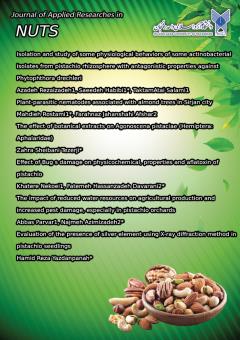Evaluation of the presence of silver element using X-ray diffraction method in pistachio seedlings
Subject Areas :
1 -
Keywords: pistachio, X-ray diffraction, heavy element, silver crystals,
Abstract :
In Iran, pistachios, as a strategic product, have a special place among agricultural products and account for a major part of non-oil exports. Therefore, studying its various aspects is important. The use of new methods in measuring substances in laboratory samples in recent years has caused a revolution in biological sciences. One of these methods is the use of X-ray diffraction. Using this method, they identify and measure particles and their distances. This article is especially important for heavy elements that are absorbed in small amounts in the plant but have a considerable effect on the biological cycle. One of the advantages of this method is the speed, accuracy and simplicity in preparing the samples The results of this experiment indicated that X-ray diffraction can be used as a diagnostic method for the presence or absence of an element in a plant. It is also possible to confirm the presence of crystals in a sample using this method The effect of zinc and iron elements individually or together on the absorption and formation of silver crystals in the plant was another result of this experiment It was found that zinc has a positive effect on the formation of silver particles, while iron did not affect this process.
1. Ahmad, N., Sharma, S., Singh, V.N., Shamsi, S.F., Fatma, A. and Mehta, B.R. 2011. Biosynthesis of silver Nanoparticles from Desmodium triflorum:A novel approach towards weed utilization. Biotechnology research international, 10: 4061-4069.
2. Ardakani, A.S. 2005. The vital role of pistachio processing industries in development of Iran non-oil exports. In: Paper Presented at the IV International Symposium on Pistachios and Almonds. 726.
3. Barrett, C.S. and Massalski, T.B., 1966. "Structure of Metals", 3rded, McCraw-Hill, New York, PP.251- 254.
4. Berry, C.R., 1947. "Phys.Rev", 72: 942.
5. Bragg, W.I., 1949."The Crystalline State", AGeneral Survey, G.Bell, London, 1: 189.
6. Gupta, S.K., Scott, C. and Mitra, A. 2011. Advances in land resource management for 21st century. Soil Conservation Society of India, New Delhi. 446-446.
7. Imran, M.A., Sajid, Z.A. and Chaudhry, M.N. 2015. Arsenic (As) toxicity to germination and vegetative growth of sunflower (Helianthus annuus L.). Polish Journal of Environmental Studies. 24 (5): 1993-2002
8. Jha, A.K., Prasad, K., Prasad, Ka. and Kulkarni, A.R. 2009. Plant system: Natures nanofactory. Colloids and surfaces B: Biointerfaces, 73: 219-223
9. Khan, M.J. and Jones, D.L. 2009. Effect of compost, lime and DAP on the phyto availability of heavy metals in copper mine tailing soils. Pedosphere, 19: 631-641.
10. Khan, M.U., Shahbaz, N., Waheed, S., Mahmood, A., Shinwari, Z.K. and Malik, R.N. 2016. Comparative health risk surveillance of heavy metals via dietary food stuff consumption in different land-use types of Pakistan. Human Ecological Risk Assessment: An International Journal, 22: 168-186.
11. Langford, J.I. and Wilson, A.J.C. 1978. Scherrer after sixty years:Asurvey and new results in the determination of crystallite size, Journal of Applied Crystallography, 11: 102-113
12. Majd, A. and Shariatzadeh, M., 2003. Molecular Cell Biology. IJ. Tehran. (In Persian)
13. Rizwan, M., Ali, S., Qayyum, M.F., Ibrahim, M., Rehman, M.Z., Abbas, T. and Ok, Y.S. 2016. Mechanisms of biochar-mediated alleviation of toxicity of trace elements in plants: a critical review. Environnemental Science Pollution Research. 23: 2230-2248.
14. Stokes, A.R, 1948. "Proc. Phys.Soc". London, A., 61: 382.


